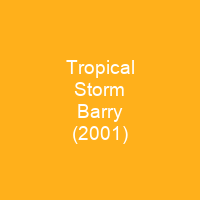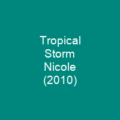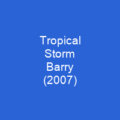Tropical Storm Barry was a strong tropical storm that made landfall on the Florida Panhandle during August 2001. Barry was the third tropical cyclone and second named storm of the 2001 Atlantic hurricane season. Six people died in Cuba and three in Florida as a result of the storm, which caused significant flooding and wind damage. Barry caused an estimated USD 30 million in damage.
About Tropical Storm Barry (2001) in brief
 Tropical Storm Barry was a strong tropical storm that made landfall on the Florida Panhandle during August 2001. Barry was the third tropical cyclone and second named storm of the 2001 Atlantic hurricane season. Barry produced heavy rainfall that peaked at 8. 9 in at Tallahassee. Gusts in the area reached 79 mph, which was the highest wind speed recording for the storm. Barry caused an estimated USD 30 million in damage. Unlike the devastating Tropical Storm Allison earlier in the season, Barry’s effects were moderate. Six people died in Cuba and three in Florida as a result of the storm, which caused significant flooding and wind damage. Barry dissipated on August 7 after moving ashore along the Gulf Coast before dissipating on August 8. The precursor tropical wave to Barry dropped large amounts of rain on southern Florida, leading tosignificant flooding and structural damage. The storm’s remnants tracked inland, and parts of the Mississippi Valley received light precipitation. The remnants of Barry are now a remnant low and drifted northwest at about 7 mph. The remnant low turned northwest and weakened steadily to a tropical low and a remnant tropical storm on August 6.
Tropical Storm Barry was a strong tropical storm that made landfall on the Florida Panhandle during August 2001. Barry was the third tropical cyclone and second named storm of the 2001 Atlantic hurricane season. Barry produced heavy rainfall that peaked at 8. 9 in at Tallahassee. Gusts in the area reached 79 mph, which was the highest wind speed recording for the storm. Barry caused an estimated USD 30 million in damage. Unlike the devastating Tropical Storm Allison earlier in the season, Barry’s effects were moderate. Six people died in Cuba and three in Florida as a result of the storm, which caused significant flooding and wind damage. Barry dissipated on August 7 after moving ashore along the Gulf Coast before dissipating on August 8. The precursor tropical wave to Barry dropped large amounts of rain on southern Florida, leading tosignificant flooding and structural damage. The storm’s remnants tracked inland, and parts of the Mississippi Valley received light precipitation. The remnants of Barry are now a remnant low and drifted northwest at about 7 mph. The remnant low turned northwest and weakened steadily to a tropical low and a remnant tropical storm on August 6.
It is unclear whether Barry actually held tropical characteristics at the time of designation, because of an upper-level low that was situated over the cyclone’s surface center. The cyclone became embedded within a mid- to-upper-level trough between the ridge over the central U.S. and the ridgeover the northwestern Caribbean. A strong, upper- level cyclonic shear axis extended from just south of Cape Hatteras to near Brownsville, Texas, which prevented Barry from accelerating in forward speed. The system weakened into a tropical depression early on August 4 due to the persistent wind shear and falling external pressure. On August 5, a strengthening period began as deep convection ignited over and near the low-level center. Within seven hours, the barometric pressure dropped from 1004 mb to 990 mb and overall satellite presentation had begun to improve. Barry reached its peak winds of 70 mph just shy of hurricane status on August 5. By the evening of August 6, maximum sustained winds near the center were around 5 mph.
You want to know more about Tropical Storm Barry (2001)?
This page is based on the article Tropical Storm Barry (2001) published in Wikipedia (as of Nov. 05, 2020) and was automatically summarized using artificial intelligence.







